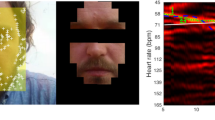Abstract
The finger blood pressure monitor measures blood pressure continuously and noninvasively by means of a technique described by J. Peňaz. The size of the artery is measured when its internal pressure (arterial pressure) equals the external pressure. (At this point, transmural pressure equals zero and the arterial wall is said to be “unloaded.”) This unloaded condition is maintained by continuous, automatic adjustments of external pressure on the artery, adjustments that are made simultaneously with and parallel to intraarterial pressure variations. The external pressure then constantly equals internal pressure (arterial blood pressure) and is reported by the monitor as values for systolic, mean, and diastolic pressure. A finger cuff with a built-in light source and detector is used to measure finger artery size, and an inflatable bladder is used to apply the external pressure to the artery. The monitor is microprocessor based; algorithms determine the unloaded artery size approximately every minute and automatically correct for changes possibly induced by smooth muscle contraction or relaxation, and a high-speed electropneumatic servo control system enables automatic calibration and adjustment.
Similar content being viewed by others
References
Guyton AC. Textbook of medical physiology. Philadelphia: Saunders, 1971:270–310
Rushmer RF. Cardiovascular dynamics, 3rd ed. Philadelphia: Saunders, 1970:148,260
The Committee on Exercise. Exercise testing and training of individuals with heart disease or at high risk for its development: a handbook for physicians. Dallas, American Heart Association, 1975
Peňaz J. Photoelectric measurement of blood pressure, volume and flow in the finger. In: Digest of the 10th International Conference on Medical and Biological Engineering. Dresden, 1973:104
Wesseling KH, Settels JJ, de Wit B. The measurement of continuous finger arterial pressure noninvasively in stationary subjects. In: Schmidt TH, Dembroski TM, Blumchen G, eds. Biological and psychological factors in cardiovascular disease. Berlin: Springer-Verlag, 1986:355-375
Langewouters GJ, Zwart A, Busse R, Wesseling KH. Pressure-diameter relationships of segments of human finger arteries. Clin Phys Physiol Meas 1986;7:43–55
Hirai M, Neilsen SL, Lassen NA. Blood pressure measurement of all five fingers by strain gauge plethysmography. Scand J Clin Lab Invest 1976;36:627–632
Manning DM, Kuchirka C, Kaminski J. Miscuffing: inappropriate blood pressure cuff application. Circulation 1983;68:763–766
Kurki TS, Smith NT, Head N, et al. Noninvasive continuous blood pressure measurement from the finger: factors affecting the measurement. Anesthesiology 1986;65:A134
Smith NT, Wesseling KH, de Wit B. Evaluation of two prototype devices producing noninvasive, pulsatile, calibrated blood pressure measurement from a finger. J Clin Monit 1985;1:17–29
Wesseling KH, Settels JJ, van der Hoeven GMA, et al. Effects of peripheral vasoconstriction on the measurement of blood pressure in the finger. Cardiovasc Res 1985;19:139–145
van Egmond J, Hasenbos M, Crul JF. Invasive v. noninvasive measurement of arterial pressure. Br J Anaesth 1985;57:434–444
Molhoek GP, Wesseling KH, Settels JJM, et al. Evaluation of the Peňaz servo-plethysmo-manometer for the continuous, noninvasive measurement of finger blood pressure. Basic Res Cardiol 1984;79:598–609
Gravenstein JS, Paulus DA, Feldman J, McLaughlin G. Tissue hypoxia distal to a Peňaz blood pressure cuff. J Clin Monit 1985;1:120–125
Author information
Authors and Affiliations
Additional information
The author thanks the many engineers from The Netherlands and from Ohmeda Monitoring Systems who took part in the development of the Finapres, and the still more clinicians who encouraged and participated in the clinical evaluations. The author also expresses deepest thanks to Karel H. Wesseling and his research and development group at the Academic Medical Center, Amsterdam, The Netherlands, who made this all possible.
Rights and permissions
About this article
Cite this article
Boehmer, R.D. Continuous, Real-Time, Noninvasive Monitor of Blood Pressure: Peňaz Methodology Applied to the Finger. J Clin Monitor Comput 3, 282–287 (1987). https://doi.org/10.1007/BF03337384
Received:
Revised:
Accepted:
Published:
Issue Date:
DOI: https://doi.org/10.1007/BF03337384




